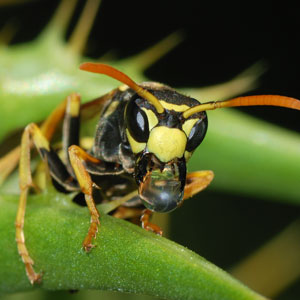Wiping Out Wasps
By Chris Williams on April 1, 2014.
 Katlyn Graham: Hello. I’m Katlyn Graham here with Tim Chace, a pest control technician with Colonial Pest and an entomologist.
Katlyn Graham: Hello. I’m Katlyn Graham here with Tim Chace, a pest control technician with Colonial Pest and an entomologist.
Today we’re talking about wasps. ‘Tis the time of year, Tim, for insects to come out like wasps. What kind of wasps are we dealing with around here?
Tim Chase: There are four major types of wasps, that we deal with in this area. The two most common would be the Northern Paper Wasps, that’s the reddish‑brown guy with long legs.
And then there’s the European Banded Paper Wasps, a smaller yellow and blackish fellow. The hallmark of these two wasps would be small paper nests.
Another wasp that we encounter frequently would be the Mud Dauber wasp. He’s a larger black metallic twitchy thing. They make what looks like a hockey puck on the side of the house with little clay chambers, where they put their eggs and larvae.
The fourth type of wasp that we deal with are the yellow jacket or Vespid species, very aggressive wasps that tend to nest in wall voids within the structure.
All of these wasps can sting and have various amounts of aggressiveness. The mud dauber would be the least aggressive.
Then you get down to the yellow jackets, which are very aggressive defending their nest, especially later in the season as the nest can become very large.
Katlyn: That’s the danger with the wasps, that they’ll come and sting you.
Tim: Exactly. Let’s say, for example, you’ve got a nest up in the gas grill and you haven’t used the grill for a while. You could open that right up and they would sting you right there, just in a defensive mode.
Most of the time, people get stung when you don’t know where the nest is. Let’s say it’s up under the shutters and you’re cleaning the shutters.
You go to take the shutter off and there’s a whole bunch of these paper wasp nests right there. Not a terrible thing, but if you’re on a ladder, it can be an issue.
Katlyn: Oh, for sure. Now, what do you do if you find a nest?
Tim: The first thing would be to slowly back away from it. Typically, if you’re moving fairly slowly, these things won’t see you as well.
But we recommend calling a pest control professional in most cases. Smaller nests, you could spray it with a cane of home pesticide or knock it off with a broom.
But we’ve got safe and effective methods to remove even the largest yellow jacket nest. We’ve got a bee suits and specialized equipment that allow us to take the fight right to them without getting stung.
Professionals are better equipped than most homeowners in dealing with wasps nests.
Katlyn: Definitely. you don’t want to get stung. That definitely hurts.
Tim: No, especially if you’re allergic. There can be some severe health issues, especially if you get into a multiple sting event.
Let’s say you’re mowing the lawn with your lawn mower and you run over an in ground nest, you could have upwards of 50 stings. If you are allergic to yellow jackets or bees, that could be a serious health issue right there.
Katlyn: Oh, gosh. What can I do to prevent wasps from settling around my house?
Tim: A lot can be done by sealing up the gable vents, making sure that there’s tight screening around the soffit edges.
Sealing any potential openings around the structure, behind light switches and outlets, making sure that the screens and screen doors fit tightly.
Inspecting, from time to time, around the property is, as wasp nests grow, they become more visible and you can see the worker wasps coming and going from the nest. Periodic inspections of the structure can also reveal hidden wasp nests.
Another thing I highly recommend as we’re pruning bushes in the mid‑summer, would be to tap the bush a few times with the rake before you start cutting. That way if there’s any wasp activity, you’ve got a little bit more chance of escaping from it.
Sometimes they can be hard to see back in the foliage, you’re going about your business, trimming and then, “Ah!” you get stung. It’s quite a panic if you don’t know what’s happening.
Getting some disturbance into bushes and just looking around for coming and going is a great way to protect yourself from wasps as you’re working around the structure.
Katlyn: As it becomes warmer, I’m sure we’ll be seeing more and more of these wasps. Thank you so much, Tim, for joining us today.
Tim: It’s been a pleasure.
Katlyn: I appreciate it.
